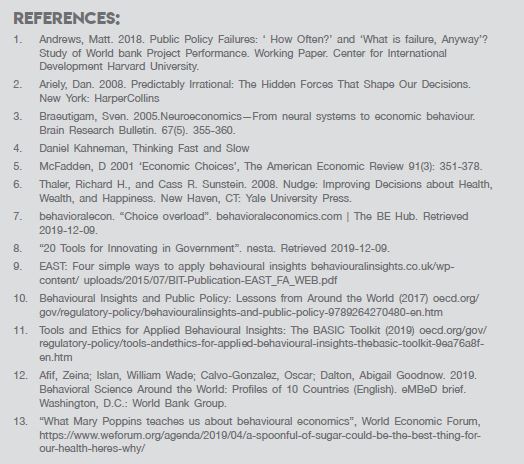by | Mohd Hasan Mohd Saaid, hasan@might.org.my | Dr. Nurul Shamisza Sahrom, shamisza@kpdnhep.gov.my
Nurul Shamisza binti Sahrom is currently an administrative and diplomatic officer at the Ministry of Domestic Trade and Consumer Affairs. She holds a PhD in Brain Dynamic and a Master’s Degree in Business Administration (International Business) from Universiti Sains Malaysia. In 2007, Shamsiza graduated with a Bachelor’s Degree in Biological Science (Plant Biology). Since, her interdisciplinary education background and passion in public policy have driven her change efforts on individual cognitive styles and behavioural research . To date , Shamsiza has published a variety of research work and papers across national and international publications in addition to receiving a number of awards for outstanding publications.
Foresight tools as policy enabler provide access to understanding trends and issues, firming destination (visioning) and anticipating the future. The world we are living now involve element of volatility, uncertainty, complexity and ambiguity known as VUCA world. Solving wicked problem is a tricky and sometimes resulted in unintended consequences. Tools like behavioural insights could be leveraged as part of foresight tools in enabling decision making for government and businesses.
Governments can only solve complicated challenges like obesity or climate change with the help of changes in public behaviour. Classic policy tools like publicly-provided services, taxes or subsidies can play a part. But on their own they’re rarely enough. For example, cutting carbon emissions may involve encouraging people to use their cars less, or pay closer attention to household energy use.
One widely used definition of behavioural change at individual level is given by Bandura (1977): “A behavioural change can be a temporary or permanent effect that is considered a change in an individual’s behaviour when compared to previous behaviour.” This change is generally characterised by changes in thinking, interpretations, emotions, or relationships. These changes can be either good or bad,depending on which behaviour is being affected.”
Policymakers are increasingly turning to the behavioral sciences to tackle intractable policy challenges, including increasing student learning, raising savings rates, promoting energy and resource conservation, increasing productivity, improving sanitation practices, strengthening institutions, and reducing corruption.
What is Behavioural Insight?
When in dividuals are thinking automatically, a mere “nudge” may change their behavior. A nudge is a policy that achieves behavior change without actually changing the set of choices. It does not forbid, penalise, or reward any particular choices. Instead, it points people toward a particular choice by changing the default option, the description, the anchor, or the reference point. To encourage people to choose a more healthy diet, for example, according to Thaler and Sunstein, “Putting the fruit at eye level counts as a nudge. Banning junk food does not” (2008, 6). Putting the fruit at eye level is a change in framing.
Policy maker who use behavioural insights known as ‘choice architect’. A choice architect is someone who organises the context in which people make decisions. Many people are choice architects, most without realising it. Think of doctors describing the available treatments to patients, matchmakers describing marriage choices, or moneylenders describing loan products. Choice architecture influences decision making by simplifying the presentation of options, by automatically evoking particular associations, or by making one option more salient or easier to choose than the alternatives (Thaler and Sunstein 2008).
A component of choice architecture is simplicity. Too many options or too much complexity may lead individuals to avoid thinking through a decision, to postpone indefinitely making an active decision, or to make error-ridden decisions. Consider an example in voting in which individuals may have to make choices in scenarios for which they have limited experience and little or no education or training to prepare them.
Policies that create reminders or remove small impediments in such areas as savings, adherence to health regimens, and voting in elections have had successes in narrowing intention-action divides.
Common framework : EAST Framework
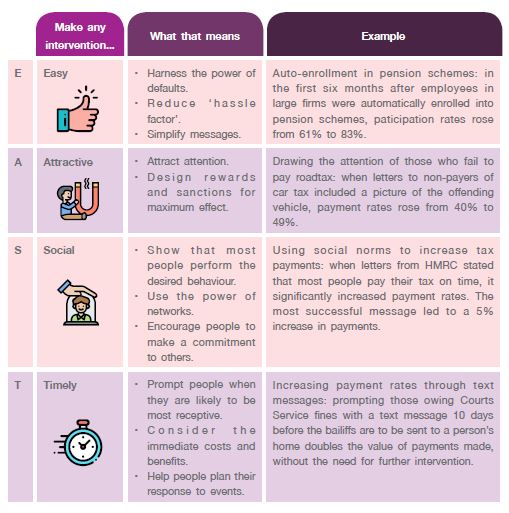
Source : NESTA
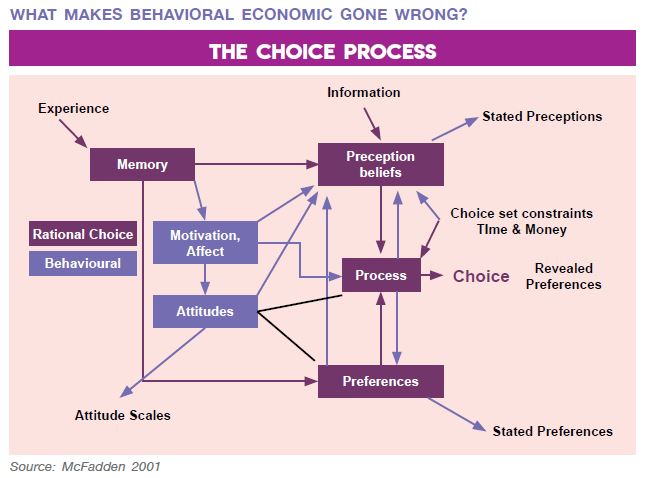

Echoes to the perspective that individual mental architecture is the fundamental to set individual behaviour, there are various challenges posed by the policy makers and industry players to change individual preference and behaviour. One might say that every people would think and react the same in a controlled environment. Does one size fits all applied? Realising that individual cognitive system is mechanically supported by memory, knowledge and belief, it put some pressure on the external environment to motivate and stimulate individual change behaviour. Individuals tend to be mentally bias when they are provided with limited information, time and emotional intervention that occasionally camouflage the individual judgement and decision.
Hyperbolic Discounting Phenomenon
In addition, individual prone to show ‘hyperbolic discounting’ situation where they tend to predispose one behaviour that arrives sooner rather than later thus discount the later value due to the instant effect and satisfaction. This makes the individual to make inconsistent decisions and choices over time and often been identified as ‘present-biased’. This phenomena often stand against the policy maker and business players dynamism thus posed challenge to the sustainable ecosystem of consumerism and business.
Social Norms
On the other hand, social norms play a major role on individual acceptance and behavioural change. This can be seen on consumer behaviour as individual geographical and cultural influence the inclination towards specific behavior. For example, there are different response on people living in the United States and China to the couponing behaviour. People in the United States tend to utilise and value the couponing as compared to China due to confucion belief that emphasise on face saving. Nevertheless, the current spending showed that Chinese American tend to adapt to American culture and inclined towards couponing behavior.
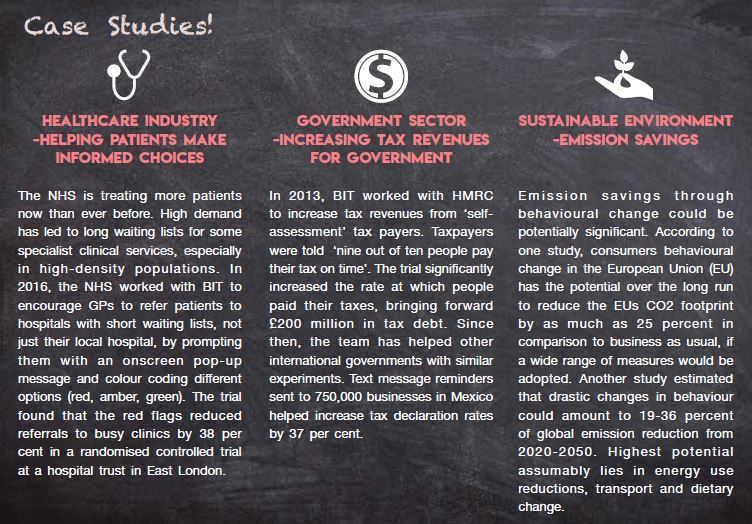
Trends of Behavioural Economics
Where does behavioral science stand in public policy? And what does its future look like?
One way to explore this question is to draw on the literature of how innovations mature. For example, the Gartner Hype Cycle argues that one can broadly identify five phases of maturity for emerging technologies:
(i) Technology trigger;
(ii) Peak of inflated expectations;
(iii) Trough of disillusionment;
(iv) Slope of enlightenment; and,
(v) Plateau of productivity.

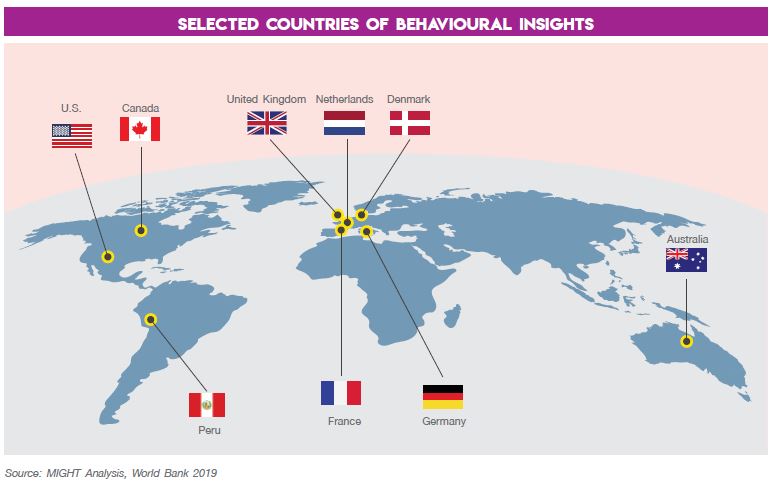
Buerkli suggests that behavioral science was entering a ‘trough of disillusionment,’ as expectations about the promise of behavioral insights in public policy have proven to be overly optimistic.
The spread and form of behavioral science in 10 countries, selected based on being innovators or early adopters in the field: Australia, Canada, Denmark, France, Germany, Netherlands, Peru, Singapore, the U.S., and the UK.
The application of behavioural insights to policy is expanding across Europe. In some EU Member States, such as Germany and the UK, Centralised behavioural insights teams have been established within the national governments, while in other – e.g. Denmark, France and the Netherlands – ministries have taken the lead. Also at the global level, the World Bank and the OECD have published reports emphasising the importance of identifying and addressing behavioural elements in policy.
Behavioural Insights Driving Economics
Behavioral insights has posed greater attention among policy makers and business players to understand the effect of public policy to society behavior as some public policy works well in one society and not so well in others. A study by Andrews (2018) that examining the 400 projects of World Bank has shown that the failure rate is 24 % with regards to the project and product success meanwhile the failure rate is 51% when one takes a broader view of results on the policies impact the development and problem solved. The questions on ‘how often’ and ‘how much it costs’ the failing public policy become mind boggling and challenging among policy makers as the development and implementation of public policy absorbs amountful national resources which approximately 16% of global Gross Domestic Products. Having said that, it is crucial for the policy makers and industry players to embrace that individual predisposition towards specific behaviour involve decision making as postulated by Rational Choice Theory. In fact, greater emphasis on neurobehavioural studies showed that individual behaviour is a choice determined by their neurophysiological reactions on environmental stimuli that reflect their decisions.
Policy Implication
Behaviorally informed policy emphasises the importance of context for decision making and behavior. It examines a wide set of influences, paying attention to the social, psychological, and economic factors that affect what people think and do. It addresses details in bureaucracies, technologies, and service delivery that are often overlooked in standard policy design but that dramatically influence the effectiveness of development programs and projects, especially in low-income contexts. Behaviorally informed policy can provide creative solutions to difficult challenges, often at low cost. Finally, it helps policy makers themselves avoid some of the decision traps and biases that affect all individuals.
Can behavioural insights assist in changing consumers into;
- reduce / dump use of plastic bag.
- consume healthy diet
- change financial lifestyle
- saving for retirement
- implementation of subsidised goods in Malaysia
Business Implication
In economic theory, more choices, combination with more competition will result in a cheaper price. However less choices to the products that people tend to be knowledgeable (household product) and more choices to product that people ignorant, will resulted impacted hypermarket. The availability of financial technology has made the payment process more easy. Choice of product and services available online had drive more online than physical store. In this scenario, the unintended consequences of retails signal the future of grocery store where more hypermarket close down as a result. With pseudoscience and social media on the rise, things like ‘narrative economics’ has facilitated a new industry of social media influencers. Business owner could leverage on behavioural insights in nudging consumers towards betterment.
Conclusion
We have two systems of thinking: the automatic system and the deliberative system. When making decisions, we cannot manage without the automatic system, and it can produce remarkably well-adapted choices at a trivial cost of effort in decision making. The automatic system draws heavily on default assumptions and interpretive frames. It is very sensitive to what is salient and what associations effortlessly come to mind. Having said that, it is crucial for policy makers and business players to stimulate and shift the individual paradigm that reflect sustainable behavioural change in order to avoid costly correction policy and non competitive business landscape. As suggested by behaviorist scholars the minor and low cost policy changes do have a large impact on the achievement of development goals. The policy mechanisms includes framing, anchoring, simplification, reminders and commitment devices could help people make better decisions and enhance people’s acceptance towards change.
Like other innovative policy initiatives, there is some debate on whether behavioral science is a fad or here to stay, especially given the bureaucratic nature and risk-averse culture within many public institutions. Can it work with the ‘marshmallow effect’ where gratification as key component in behavioural change? Policy makers need to really understand where to use ‘marshmallow effect’ or adopting ‘hyperbolic discounting’. Applying behavioural insights in foresight practice can be at the level of strategy formulation. Due to its nature, user need to review its second and third implications in adoption.
